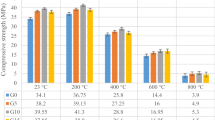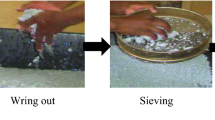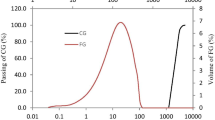Abstract
In this paper, a comparative study of the mechanical behavior of mortars with cement replacement by wood waste ash (WWA) of 0, 0.5, 1 and 3% by weight was performed. Physical and chemical properties such as density, dynamic modulus of elasticity and compressive strength were evaluated after 7, 30 and 90 days of curing. WWA and cement were analyzed by means of X-ray diffraction and X-ray fluorescence. After failure, the composites were characterized using scanning electron microscopy. The results of the study demonstrate that mortars modified with 0.5% of WWA comply with the Colombian construction requirements, being slightly better in compressive strength and with lower density compared to mortars without modification. The use of WWA as replacement of cement results in weight savings of 4.5, 9 and 27 kg for 0.5, 1 and 3% of WWA, respectively. The mortars are suitable to be used on cement composites due to their adequate physicochemical properties and their positive effect from the sustainability standpoint.








Similar content being viewed by others
References
Abdul Kadir, A., & Mohajerani, A. (2011). Bricks: an excellent building material for recycling wastes–a review.
Abdullahi M (2006) Characteristics of wood ash/OPC concrete. Leonardo Electron J Pract Technol 8:9–16
Aldebert P, Traverse J (1982) Neutron diffraction study of structural characteristics and ionic mobility of a-Al2O3 at high temperatures. J Am Ceram Soc 65(9):460–464
American Society for Testing and Materials. Committee C-1 on Cement (2013) Standard test method for compressive strength of hydraulic cement mortars (using 2-in. Or [50-mm] cube specimens). ASTM International.
Argiz Lucio CG (2014). Estudio de la utilización de las cenizas de cenicero de centrales termoeléctricas de carbón como adición del cemento portland: análisis comparativo con las cenizas volantes.
Cheah CB, Ramli M (2011) The implementation of wood waste ash as a partial cement replacement material in the production of structural grade concrete and mortar: an overview. Resour Conserv Recycl 55(7):669–685
Chowdhury S, Mishra M, Suganya O (2015) The incorporation of wood waste ash as a partial cement replacement material for making structural grade concrete: an overview. Ain Shams Eng J 6(2):429–437
Corinaldesi V, Mazzoli A, Siddique R (2016) Characterization of lightweight mortars containing wood processing by-products waste. Constr Build Mater 123:281–289
Elinwa AU, Ejeh SP (2004) Effects of the incorporation of sawdust waste incineration fly ash in cement pastes and mortars. J Asian Archit Build 3(1):1–7
dos Santos SF, Tonoli GHD, Mejia J, Fiorelli J, Savastano H Jr (2015) Non-conventional cement-based composites reinforced with vegetable fibers: a review of strategies to improve durability. Mater Constr 65(317):041
Dugat J, Roux N, Bernier G (1996) Mechanical properties of reactive powder concretes. Mater Struct 29(4):233–240
Elinwa AU, Ejeh SP, Akpabio IO (2005) Using metakaolin to improve sawdust-ash concrete. Concr Int 27(11):49–52
Elinwa AU, Ejeh SP, Mamuda AM (2008) Assessing of the fresh concrete properties of self-compacting concrete containing sawdust ash. Constr Build Mater 22(6):1178–1182
Elinwa AU, Mahmood YA (2002) Ash from timber waste as cement replacement material. Cement Concr Compos 24(2):219–222
Fuller A, Stegmaier M, Schulz N, Menke M, Schellhorn H, Knödler F et al (2018) Use of wood dust fly ash from an industrial pulverized fuel facility for rendering. Constr Build Mater 189:825–848
Garcia Calvo JL, Hidalgo A, Alonso Alonso MC, Luxán Gómez del Campillo M del P de, Fernández Luco L (2010) Caracterización de residuos procedentes de los procesos de combustión de biomasa. Viabilidad de uso como materiales de Construcción.
Gil H, Ortega A, Pérez J (2017) Mechanical behavior of mortar reinforced with sawdust waste. Proc Eng 200:325–332
Guzmán MFS, Ruiz DDP, Sarmiento CO, Grammes F (2013) Evaluación de las propiedades mecánicas de morteros modificados con ceniza proveniente de la desorción térmica de aguas de la industria petrolera. Cem Hormigón 956:10–14
Inga PR, Castillo MU (2016) Caracteristicas fisico-quimicas de la madera y carbon de once especies forestales de la Amazonia Peruana. Revista Forestal del Peru 14(2):1
Lafhaj Z, Goueygou M, Djerbi A, Kaczmarek M (2006) Correlation between porosity, permeability and ultrasonic parameters of mortar with variable water/cement ratio and water content. Cem Concr Res 36(4):625–633
Li J, Li L, Stott F (2004) Crystallographical analysis of surface layers of refractory ceramics formed using combined flame spray and simultaneous laser treatment. J Eur Ceram Soc 24(10–11):3129–3138
Maheswari CU, Reddy KO, Muzenda E, Guduri B, Rajulu AV (2012) Extraction and characterization of cellulose microfibrils from agricultural residue–Cocos nucifera L. Biomass Bioenerg 46:555–563
Menéndez E, Álvaro A, Argiz C, Parra J, Moragues A (2013) Characterization of bottom ashes from coal pulverized power plants to determine their potential use feasibility. Bol Soc Esp Ceram Vidiro 52:296–304
Moon J, Wang Z, Kim MO, Chun S-C (2016) Strength enhancement of alkaline activated fly ash cured at ambient temperature by delayed activation of substituted OPC. Constr Build Mater 122:659–666
Naik TR (1999) Tests of wood ash as a potential source for construction materials. Report NoCBU-1999–09. Milwaukee: UWM Center for By-products utilization, Department of Civil Engineering and Mechanics, University of Wisconsin-Milwaukee, 61.
Norby P (1997) Synchrotron powder diffraction using imaging plates: crystal structure determination and Rietveld refinement. J Appl Crystallogr 30(1):21–30
Pavlíková M, Zemanová L, Pokorný J, Záleská M, Jankovský O, Lojka M et al (2018) Valorization of wood chips ash as an eco-friendly mineral admixture in mortar mix design. Waste Manage 80:89–100
Ramos T, Matos AM, Sousa-Coutinho J (2013) Mortar with wood waste ash: Mechanical strength carbonation resistance and ASR expansion. Constr Build Mater 49:343–351
Siddique R (2007) Waste materials and by-products in concrete. Springer, Berlin
Thomas M, Shehata M, Shashiprakash S (1999) The use of fly ash in concrete: classification by composition. Cem Concr Aggregates 21(2):105–110
Udoeyo FF, Inyang H, Young DT, Oparadu EE (2006) Potential of wood waste ash as an additive in concrete. J Mater Civ Eng 18(4):605–611
Wei YM, Tomita B, Hiramatsu Y, Miyatake A, Fujii T, Fujii T, Yoshinaga S (2003) Hydration behavior and compressive strength of cement mixed with exploded wood fiber strand obtained by the water-vapor explosion process. Journal of wood science 49(4):317–326
Zhang Z, Olek J, Diamond S (2002) Studies on delayed ettringite formation in early-age, heat-cured mortars: I. Expansion measurements, changes in dynamic modulus of elasticity, and weight gains. Cem Concr Res 32(11):1729–1736
Acknowledgments
The authors are grateful to MSc. Juan Carlos Cardona for his knowledge and support. This work was supported by Dirección de Investigación (Proyectos de investigación sede central Politécnico Colombiano Jaime Isaza Cadavid, 2016).
Author information
Authors and Affiliations
Corresponding author
Additional information
Publisher's Note
Springer Nature remains neutral with regard to jurisdictional claims in published maps and institutional affiliations.
Rights and permissions
About this article
Cite this article
Castrillón, J.J., Gil, H. Mechanical properties of mortars modified with wood waste ash. J Indian Acad Wood Sci 17, 90–99 (2020). https://doi.org/10.1007/s13196-020-00258-w
Received:
Accepted:
Published:
Issue Date:
DOI: https://doi.org/10.1007/s13196-020-00258-w




